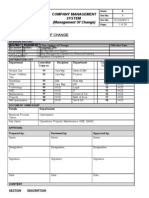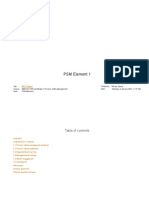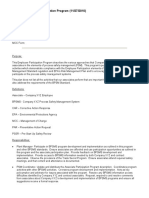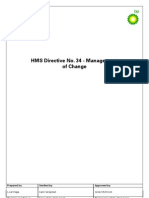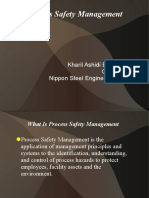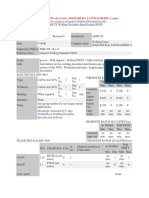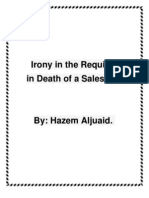MOC Guidance
MOC Guidance
Uploaded by
Sergiu LungCopyright:
Available Formats
MOC Guidance
MOC Guidance
Uploaded by
Sergiu LungOriginal Description:
Copyright
Available Formats
Share this document
Did you find this document useful?
Is this content inappropriate?
Copyright:
Available Formats
MOC Guidance
MOC Guidance
Uploaded by
Sergiu LungCopyright:
Available Formats
MOC Process
By Carl Harrison
Managing Change in
Manufacturing &
Production Facilities
Why Do We Need a
Management of Change Process?
The incidents that occurred in 1974 at the Nypro
UK plant in Flixborough and in 1984 at the Union
Carbide plant in Bhopal, India, are examples of change
gone terribly wrong.
At Flixborough, a 20-in. pipe was installed, bypassing a damaged reactor to allow the plant to operate
while the reactor was repaired. Three months later,
the temporary pipe failed releasing 30 tons of flammable cyclohexane. The ensuing vapor cloud explosion
killed 28 workers, injured 89 workers and members of
the public and destroyed the plant. The piping design
and supports had not been reviewed by an engineer
or technical authority prior to makFigure 1
ing the change, and risks associated
with hydraulic surge in the piping durOSHA Management of Change Regulation
ing process upsets had not been fully
addressed.
1910.119(1) Management of change. 1) The employer shall
In the Bhopal incident, a runaway
establish and implement written procedures to manage
reaction resulted in the release of
changes except for replacements in kind) to process
methylisocyanate (MIC). The MIC
chemicals, technology, equipment and procedures; and,
cloud left the plant and drifted over the
changes to facilities that affect a covered process. 2) The
neighboring town killing thousands and
procedures shall assure that the following considerations are
injuring tens of thousands. The effects
addressed prior to any change:
of the MIC release are still felt in
Bhopal today. A contributing factor in
(i) the technical basis for the proposed change;
the incident was the temporary bypass
(ii) impact of change on safety and health;
of some plant safety systems. Risks
(iii) modifications to operating procedures;
associated with safety system bypass
at the same time as a runaway reaction
(iv) necessary time period for the change; and
were not considered and properly
(v) authorization requirements for the proposed change.
managed.
As illustrated here, improperly man3) Employees involved in operating a process and maintenance
aged risks can have serious and someand contract employees whose job tasks will be affected by a
times fatal consequences. Because of
change in the process shall be informed of, and trained in, the
these incidents, other accidents in the
change prior to startup of the process or affected part of the
U.S. and inconsistent change manageprocess. 4) If a change covered by this paragraph results in a
ment practices in the chemical and
change in the operating procedures or practices required by
refining industries, OSHA enacted the
paragraph (d) of this section, such information shall be
process safety management (PSM) regupdated accordingly. 5) If a change covered by this paragraph
ulation in the early 1990s. Two of the
results in a change in the operating procedures or practices
main components of the PSM regulation
required by paragraph (f) of this section, such procedures or
are management of change (MOC) and
practices shall be updated accordingly.
prestartup safety review (PSSR).
hange is all around us. As soon as a plant or
processing facility is commissioned, employees and engineers begin to think of ways to
make it better. Vendors develop new and
improved products. Equipment needs to be
bypassed or temporary repairs need to be made to
reach the next turnaround. Leak-repair clamps are
installed to stop environmental releases.
Changes like these will require updating procedures, modifying the existing equipment or adding new
equipment. A robust management of change process
can help prevent these improvements from creating
problems ranging from off-spec product to catastrophic
events.
6
ByDesign www.asse.org 2012
The OSHA PSM MOC Element
& the Relationship to Safety
& Other PSM Elements
The OSHA PSM regulations intent
is similar to most companies safety programmanage risk and ensure workers
well-being. The MOC and PSSR portions
of the PSM regulation do this by requiring
change-related risks to be identified and
assessed; appropriate authorization to be
granted; changes to be communicated to
affected workers; procedures and reference
information to be updated accordingly; and
a final review to be completed to ensure that
the change is safe to operate.
MOC and PSSR are related to the process safety information, operating procedures, training, mechanical integrity and
contractors PSM elements. MOC and PSSR
help ensure that these elements are considered and addressed whenever a change is
made to the PSM-covered process.
Figure 2
OSHA Prestartup Safety Review Regulation
1910.119(i) Prestartup review. 1) The employer shall perform a prestartup
safety review for new facilities and for modified facilities when the
modification is significant enough to require a change in the process safety
information. 2) The prestartup safety review shall confirm that prior to the
introduction of highly hazardous chemicals to a process:
(i) Construction and equipment is in accordance with design
specifications.
(ii) Safety, operating, maintenance and emergency procedures are in
place and are adequate.
(iii) For new facilities, a process hazard analysis has been performed and
recommendations have been resolved or implemented before startup;
and modified facilities meet the requirements contained in
management of change, paragraph (1).
(iv) Training of each employee involved in operating a process has
been completed.
MOC Process
The MOC process must address changes
that range from minor changes to major capital projects as well as handling temporary and permanent
changes. This can be accomplished in many ways. Some
companies have developed one-size-fits-all MOC processes that are used for every change. Other companies
find it easier to have multiple MOC systems. The multiple systems can be split based on the type of change
(equipment vs. procedural), the duration (temporary vs.
permanent) or the size of the change (minor vs. major).
The decision to use an electronic MOC process or a
paper process should also be considered. The important
thing to remember is that the MOC process or processes
should be flexible, easy to use and fit your plant culture.
A basic MOC process contains the following steps:
initiation;
preliminary review;
risk assessment/technical review;
approval to design/construct;
design/construct/precommissioning;
PSSR;
approval to start up;
follow-up activities.
In the initiation step, any employee should be able
to propose a change to a procedure, equipment or technology of the PSM-covered process. The MOC forms
should allow the initiator to document the what, why
and when of the proposed change. The initiator then
forwards the information to a member of the facility
management team for review and approval.
The preliminary review consists of a go/no go
decision based on the information supplied by the
initiator. This may include discussions between the ini-
tiator and the reviewer to clarify the details of the proposed change and alignment with the facilitys needs.
If the decision is made to proceed with the change, the
preliminary reviewer should, as much as s/he is able,
document the technical basis for the change, impact
on safety and health and the timeframe to accomplish
the change. If the change is temporary, the preliminary
reviewer should also ensure that the date that the temporary change will be reverted to normal is included in
the MOC documentation.
The risk assessment/technical review step is one of
the most important activities within the MOC process.
It is critical to involve the facility engineer, technical
authority or someone with a deep understanding of the
PSM-covered process in this step. The risk assessment
should match the complexity of the change. For minor
changes, it may be okay to ask the question What
if? More complex changes require tools like process
hazard analysis or failure mode-effect analysis. Some
companies find it useful to include a risk assessment
checklist in their MOC process. The checklist includes
questions like Does this change involve a shutdown
or safety system? and Does this change increase
or decrease the pressure, temperature or flow rates
within the process? The completed checklist can be
the risk assessment or it can point the user toward a
more sophisticated risk assessment tool or additional
review by safety, environmental or technical experts.
Regardless of the risk assessment method, it is important to document what could reasonably go wrong and
the steps required to prevent it within the MOC prior to
obtaining approval to design/construct.
7
ByDesign www.asse.org 2012
The approval to design/construct step is typically
granted by the facility superintendent or manager. This
person is committing resources toward completing
the change and agreeing that the change can safely be
made based on the information provided.
Most of the real work is accomplished in the
design/construct/precommission step. In this step,
final designs are completed, piping and equipment
constructed, procedures updated, redline drawings created and equipment installation verified. If the design
changes during this step, another round of risk assessment and approval is critical to ensure that risks associated with the new design are properly managed.
The PSSR step consists of the set of verifications
and assurances that each portion of the work associated with the change has been properly completed. The
PSSR items are typically assigned to multiple people,
including facility engineers, operations leaders and
maintenance leaders. A PSSR must include the following items:
equipment meets the design specifications and has
been properly installed;
adequate safety, operating, maintenance and emergency procedures have been developed or existing procedures modified accordingly;
process hazard analyses have been completed
for new facilities and recommendations have been
resolved or implemented before startup;
employees involved in operating the PSM-covered
process have been trained on or notified of the change
as appropriate;
safe work practices have been revised accordingly;
process safety information used by employees (e.g.,
piping and instrumentation diagrams, equipment spec
sheets) has been updated accordingly;
items that will be needed in the future have been
assigned for completion. This typically includes
items like coordinating spare parts inventory with
purchasing.
Once the PSSR is complete, the MOC is forwarded
Figure 3
Sample MOC Review Checklist
8
ByDesign www.asse.org 2012
to the facility superintendent or manager for startup
approval. By granting startup approval, the manager
or superintendent is confirming that the requirements
of MOC and PSSR have been completed properly
and that the change is safe to start or to make active.
Because of this, the superintendent or manager
should have a solid, working understanding of the
facility MOC process as well as the requirements of
OSHAs PSM standard.
As mentioned, follow-up activities need to be
assigned to individuals for completion. The MOC process should be robust enough to ensure that these items
are not forgotten as the next project or initiative moves
to peoples inbox. Most companies will not close an
MOC until the follow-up activities are completed.
Improving the MOC Process
The best way to ensure that the MOC process is
working is to conduct periodic self-assessments or
reviews. The review may be conducted by anyone
with a solid understanding of the MOC process and
should include a representative number of MOCs for
the last 3 to 6 months. It is often better to have a person outside the department perform the review. This
gives a level of independence to the review and helps
find problems that someone inside the system may
overlook. Many companies use a checklist or other
guide to help obtain consistent results. The results
can be used for individual coaching or to indicate
areas of the MOC process that need to be improved.
Common MOC Problem Areas
& How to Avoid Them
Complexity
Some MOC processes attempt to be a one-sizefits-all system. As a result, they are so complex that
the users find it difficult to complete an MOC. This
can lead to frustration and can also cause people to
bypass the process for small changes because it is not
worth the effort to run a small change through the
system leading to some changes not being adequately
managed. To help avoid this, consider having separate
MOC processes that are specifically tailored for small
changes or changes to procedures and documentation.
Another method of handling this is to have a simple
base MOC process that includes supplemental checklists or features that are only used when needed.
and rosters so that the employees can review and sign
off. Others use electronic systems or e-mail to document the communication or training. Either method
is fine as long as the facility ensures that employees
returning from time off due to shift schedules, vacation, etc., review the MOC information on their first
shift back to work.
Startup Before Approval is Granted
Occasionally, changes are made active prior to
receiving startup approval. Reasons for this include
emergency changes that need to be made during weekend or night shifts, superintendent or manager vacation
or misunderstanding that another approval is needed
before startup can occur. To handle changes when the
Notification & Training of Affected Employees approvers are not available, some facilities delegate
This is one of the gray areas of the PMS regulation. approval authorization to facility operations leaders
A facility is required to train and/or notify affected
and shift leaders. Others have a rotating on-call process
employees of the change, but there are no requirements where other superintendents and managers approve
to document the training or notification associated with another departments MOCs. In the case of misunderthe MOC. To avoid problems in this area, it is best to
standing regarding the second approval for startup,
follow the If you did not write it down, you did not do well-written MOC procedures with clear expectations
it approach. Some plants have a binder in the control
for each step are critical. Flowcharts and process maps
room or maintenance shop with copies of the MOC
can also be helpful.
9
ByDesign www.asse.org 2012
Not Completing Follow-Up Activities
No magic bullet will ensure that follow-up activities
are completed. Some companies use electronic systems
that automatically send notices and generate tracking
reports. Even these systems can fall short if the facility is not diligent in closing the loop and holding the
assigned people accountable to complete the tasks.
Periodic reviews, as described here, can also help identify when follow-up activities are not completed.
Temporary Changes That Last Forever
Pipe leak-repair clamps and bypass lines that have
been around a long time are both examples of temporary changes that evolve into semipermanent and
permanent changes. Some companies attempt to avoid
this situation by setting limits for how long temporary
changes can be in effect. MOC expiration dates of
120 to 180 days are typical. Other facilities conduct
technical reviews and reauthorize temporary MOCs on
a quarterly, semiannual or annual basis to ensure that
the operating conditions have not changed and that
the temporary change is still safe to operate and not
becoming permanent. Like follow-up activities, diligence and periodic reviews are the best ways to prevent temporary changes from evolving into permanent
changes.
Conclusion
The MOC process will help a facility meet the
OSHA PSM regulations, but the benefits can reach
beyond compliance. A simple, yet robust, MOC process can help ensure that risks associated with change
are understood and properly managed, employees are
trained on how the change affects them, accurate procedures are in place for maintenance and operations,
equipment files are up to date and spare parts are available when they are needed. When these elements are
in place, a facility can meet their goal of safe, reliable
operations. x
Carl Harrison is a process safety management specialist
with BP Exploration Alaska. He is a chemical engineer with
22 years experience in the oil exploration and production and
chemical manufacturing industries.
Flixborough Disaster: U.K. Health & Safety Executive
Case Study
Bhopal Disaster: U.K. Health & Safety Executive Case Study
Union Carbide Bhopal Information Center
U.S. Chemical Safety Board
Management of Change Safety Bulletin
Guidelines for the Management of Change for
Process Safety
Interested in Presenting
at Safety 2013?
f you are inter
ested in pre
senting at Safety
2013, please
keep in mind
that proposals
are due by July
2012. For
more informa
tion, click here. You can either
submit online or by e-mailing
pdcspeaker@asse.org. If you would like
to be sponsored by EngPS, please send
your proposal to ksonneson@asse.org
indicating your interest.
Health & Wellness
Branch
SSEs Healthcare Practice Specialty
(HPS) now sponsors a new Health &
Wellness Branch. The branch will estab
lish a knowledge base, tools and resourc
es to help SH&E professionals influence
employees to make appropriate lifestyle
choices; employers to provide appropri
ate tools, programs and infrastructure
that will facilitate appropriate employee
lifestyle choices; and employers to recog
nize SH&E professionals contributions as
value-added to their organizations.
Health & Wellness Branch member
ship is free to all HPS members! Members
who do not belong to HPS can join for
$20 and then join the Health & Wellness
Branch for free, so you get two for
the price of one. To join this new
branch, contact customer service at
(847) 699-2929.
To view a complimentary copy of the
Health & Wellness Branchs inaugural
issue of Wellness Report, its triannual
publication, click here.
10
ByDesign www.asse.org 2012
You might also like
- Management of Change ProcedureDocument24 pagesManagement of Change Procedurenugrasakti100% (5)
- Pre Startup Safety ReviewDocument29 pagesPre Startup Safety ReviewAhsan100% (2)
- Management of ChangeDocument39 pagesManagement of ChangeShyam Singh100% (8)
- Process Safety AuditDocument21 pagesProcess Safety AuditKailash Pandey100% (3)
- Management of ChangeDocument15 pagesManagement of ChangeMohammed Zubair86% (7)
- Managment of Change ProcedureDocument17 pagesManagment of Change ProcedureSherif Abdel Hamid Fakhry90% (10)
- Appendix: Appendix A1: Example PSSR Completion FormDocument5 pagesAppendix: Appendix A1: Example PSSR Completion FormSumantrra ChattopadhyayNo ratings yet
- 08 PSM Auditing ChecklistDocument18 pages08 PSM Auditing Checklistherik100% (2)
- Management of ChangeDocument36 pagesManagement of Changett638983% (6)
- Process Safety Capability StudiesDocument51 pagesProcess Safety Capability Studiestloganat100% (2)
- Safety Performance Indicators - Process Safety Events - 2013 Data - Fatal Incident and High Potential EventsDocument60 pagesSafety Performance Indicators - Process Safety Events - 2013 Data - Fatal Incident and High Potential EventsInternational Association of Oil and Gas ProducersNo ratings yet
- The Four Pillars of Risk Based Process SafetyDocument4 pagesThe Four Pillars of Risk Based Process SafetyRachna SinhaNo ratings yet
- AWS Disaster RecoveryDocument56 pagesAWS Disaster Recoverybal_thakre100% (2)
- Accomplishment Report On Seminar Orientation On Contigency Plan On EarthquakeDocument12 pagesAccomplishment Report On Seminar Orientation On Contigency Plan On EarthquakeSandra EladNo ratings yet
- 09 - Management of ChangeDocument19 pages09 - Management of ChangeDave C100% (1)
- Management of Change - 2013 - Rev 3Document24 pagesManagement of Change - 2013 - Rev 3hvananthNo ratings yet
- MoC - 8 Wrong PerceptionsDocument12 pagesMoC - 8 Wrong PerceptionsdanielhvillaNo ratings yet
- A Practical Approach To Managing Safety Critical Equipment and Systems in Process PlantsDocument10 pagesA Practical Approach To Managing Safety Critical Equipment and Systems in Process Plantsfredo405No ratings yet
- Wyn032 PDFDocument21 pagesWyn032 PDFWahjudi MuhammadNo ratings yet
- Pre-Startup Safety Review PDFDocument5 pagesPre-Startup Safety Review PDFÅdnAn MehmOodNo ratings yet
- Management of ChangeDocument49 pagesManagement of Changealgiorge100% (3)
- MOC Requirement Guidelines and ExamplesDocument5 pagesMOC Requirement Guidelines and ExamplesMohammed ZubairNo ratings yet
- PSM Element 1Document38 pagesPSM Element 1Mircea Caprar100% (2)
- MOC and PSSER Refresher TrainingDocument37 pagesMOC and PSSER Refresher TrainingGustavo GustavoNo ratings yet
- Practical Approach To Managing Safety Critical Equipment and Systems in Process PlantsDocument10 pagesPractical Approach To Managing Safety Critical Equipment and Systems in Process PlantsMuhammad Danish AmanNo ratings yet
- Efficient PHA of Non-Continuous Operating ModesDocument25 pagesEfficient PHA of Non-Continuous Operating ModesShakirNo ratings yet
- Progress On Process Safety IndicatorsDocument23 pagesProgress On Process Safety IndicatorsDuNo ratings yet
- PSM Auditing (Presentation)Document25 pagesPSM Auditing (Presentation)kanakarao1100% (2)
- Employee Participation ProcedureDocument4 pagesEmployee Participation ProcedureJudy PerryNo ratings yet
- KppProcess Safety AuditDocument26 pagesKppProcess Safety Auditkirandevi1981No ratings yet
- Process Safety Management System-PaperDocument11 pagesProcess Safety Management System-PaperV. Balasubramaniam100% (2)
- Engineering Position Paper Pre Start Up Safety ReviewDocument26 pagesEngineering Position Paper Pre Start Up Safety ReviewSyed Salman Haider Naqvi100% (1)
- An Engineer S Guide To MocDocument5 pagesAn Engineer S Guide To MocAnonymous 1XHScfCI100% (2)
- Diference Between HAZID and HAZOPDocument2 pagesDiference Between HAZID and HAZOPQueziaNo ratings yet
- Safety Training Presentations: Process Safety Management of Highly Hazardous Chemicals 29 CFR 1910.119 (PSM) EH&S 3-13Document22 pagesSafety Training Presentations: Process Safety Management of Highly Hazardous Chemicals 29 CFR 1910.119 (PSM) EH&S 3-13Billel Hichem HitacheNo ratings yet
- Management of Change (MOC) Procedure Template Checklist - SafetyCultureDocument8 pagesManagement of Change (MOC) Procedure Template Checklist - SafetyCultureardi yansaNo ratings yet
- Change Control Sheet: Change Request Impact AnalysisDocument3 pagesChange Control Sheet: Change Request Impact AnalysisM BaskarNo ratings yet
- ASSE 04 Process Safety ManagementDocument37 pagesASSE 04 Process Safety ManagementCarlos Cueva GallegosNo ratings yet
- Document Title: HSE Standard Manual Management of ChangeDocument12 pagesDocument Title: HSE Standard Manual Management of ChangeDhimaz Yudi100% (4)
- Risk Based Process SafetyDocument5 pagesRisk Based Process Safetykanakarao1No ratings yet
- 51 17 Management of ChangeDocument18 pages51 17 Management of Changesarifin100% (1)
- Webinar K3 2021 - PSSRDocument20 pagesWebinar K3 2021 - PSSRZulkarnaenUchiha100% (2)
- 14 Points of PSMDocument13 pages14 Points of PSMAmeerHamzaNo ratings yet
- 001-A Comparative Analysis of Process Safety Management (PSM) Systems in The Process IndustryDocument14 pages001-A Comparative Analysis of Process Safety Management (PSM) Systems in The Process IndustryMiningSafety185No ratings yet
- PSM 6 - Element 1 - Process Safety Culture (v3)Document29 pagesPSM 6 - Element 1 - Process Safety Culture (v3)Ahmed Hamad100% (2)
- HMS Directive No. 34 - Management of ChangeDocument15 pagesHMS Directive No. 34 - Management of Changeakubestlah100% (2)
- 5 Day Course Outline of Process Safety Related TopicsDocument3 pages5 Day Course Outline of Process Safety Related Topicskanakarao1No ratings yet
- S-4 Safety Critical Elements - For PresentationDocument18 pagesS-4 Safety Critical Elements - For PresentationMomoMarouf100% (2)
- Process Safety Performance IndicatorsDocument11 pagesProcess Safety Performance IndicatorsNhut NguyenNo ratings yet
- Hazop PDFDocument33 pagesHazop PDFSDP02No ratings yet
- Hse: Major Accident in Petrochemical IndustryDocument31 pagesHse: Major Accident in Petrochemical IndustryAimi SaariNo ratings yet
- Process Safety Management For Petroleum Refineries TxtbrdconsiderDocument32 pagesProcess Safety Management For Petroleum Refineries TxtbrdconsiderTehman SiddiquiNo ratings yet
- MOC Flow ChartDocument2 pagesMOC Flow ChartImran Ahmed100% (1)
- EHS-00030 R6 Equipment Decommissioning and Removal ProcedureDocument6 pagesEHS-00030 R6 Equipment Decommissioning and Removal Procedurexjaf010% (1)
- BowTieXP Training Handout-Conduccion Vehicular PDFDocument5 pagesBowTieXP Training Handout-Conduccion Vehicular PDFRoberto Burgos100% (2)
- Inherent SafetyDocument50 pagesInherent SafetyChing-Liang ChenNo ratings yet
- Process Safety Management: Kharil Ashidi B. Abdul Jabar Q-SHE-S Dept Nippon Steel Engineering Co., LTDDocument37 pagesProcess Safety Management: Kharil Ashidi B. Abdul Jabar Q-SHE-S Dept Nippon Steel Engineering Co., LTDKay Aay100% (1)
- Risk Based Process Safety 1679636677Document87 pagesRisk Based Process Safety 1679636677nhisham100% (2)
- BMB & CKD MCD VaDocument6 pagesBMB & CKD MCD VaFazrulNo ratings yet
- 0244.10MOC.1.Steam ManagementofChangeElementDescriptionDocument6 pages0244.10MOC.1.Steam ManagementofChangeElementDescriptiondavid harrisNo ratings yet
- What Is Management of Change?Document7 pagesWhat Is Management of Change?Ashish JadhavNo ratings yet
- Critical Quality Attributes Critical Process ParametersDocument40 pagesCritical Quality Attributes Critical Process ParametersSergiu LungNo ratings yet
- En Iso 6507Document11 pagesEn Iso 6507Sergiu Lung100% (2)
- WPS Asme Ix PDFDocument4 pagesWPS Asme Ix PDFSergiu LungNo ratings yet
- Acme ThreadsDocument3 pagesAcme ThreadsUNIISCRIBD100% (1)
- Sample QualitativeDocument32 pagesSample Qualitativepuertojayson77100% (1)
- IWFM Admission PREPDocument8 pagesIWFM Admission PREPKamruz zamanNo ratings yet
- De Tuyen Sinh Vao Lop 10Document2 pagesDe Tuyen Sinh Vao Lop 10My Hanh HoangNo ratings yet
- Monsoon PrecautionDocument7 pagesMonsoon Precautionajayjanardhankasle67% (3)
- Basic First AidDocument12 pagesBasic First Aidkenneth nocheNo ratings yet
- DRR1Document14 pagesDRR1lazazappNo ratings yet
- Earthquakes in Chile and NepalDocument6 pagesEarthquakes in Chile and NepalMysticalNo ratings yet
- ACTAEONDocument1 pageACTAEONLouphChristopherNo ratings yet
- IT Continuity, Backup and Recovery PolicyDocument8 pagesIT Continuity, Backup and Recovery PolicynaveedNo ratings yet
- Disaster Readiness and Risk ReductionDocument4 pagesDisaster Readiness and Risk ReductionJake DumosdosNo ratings yet
- Disaster Management Act of Bangladesh: A Discussion On Emphasizing Specific IssuesDocument27 pagesDisaster Management Act of Bangladesh: A Discussion On Emphasizing Specific IssuesShah Riaj ShuprioNo ratings yet
- The Resiliency of A FilipinoDocument1 pageThe Resiliency of A FilipinoAlyssa Rondon100% (1)
- PL WhenspillstrikesposterDocument1 pagePL WhenspillstrikespostertomiNo ratings yet
- Bpag 171Document4 pagesBpag 171rpst032No ratings yet
- Anh 8. Đề cương HKII (2023-2024)Document9 pagesAnh 8. Đề cương HKII (2023-2024)nnminhchau2010No ratings yet
- USGS Seismic Design Maps Web App IntroDocument2 pagesUSGS Seismic Design Maps Web App Intromarin_sNo ratings yet
- Scheme of Work Unit 1Document18 pagesScheme of Work Unit 1Keshya Maleeza WeerakkodyNo ratings yet
- Irony in The Requiem in Death of A SalesmanDocument5 pagesIrony in The Requiem in Death of A SalesmanSanad AllihyanyNo ratings yet
- Vaastu and Disaster Management PDFDocument18 pagesVaastu and Disaster Management PDFSham ParitNo ratings yet
- Historical Context HamletDocument2 pagesHistorical Context HamletMarcela SavaNo ratings yet
- Forest FiresDocument2 pagesForest FiresNazelna RamadhaniNo ratings yet
- ATAR-3rd NSEDDocument9 pagesATAR-3rd NSEDJuneNo ratings yet
- Flood Preparedness and Utilization of Early Warning Systems Among Households in Selected Ood-Prone Areas in Tagum City, Davao Del NorteDocument15 pagesFlood Preparedness and Utilization of Early Warning Systems Among Households in Selected Ood-Prone Areas in Tagum City, Davao Del NortelilienesieraNo ratings yet
- PDRRMS For SchoolsDocument39 pagesPDRRMS For SchoolsJester Ambojnon TuklingNo ratings yet
- Ppt1.1 Emergency and Disaster Nursing INTRODUCTIONDocument64 pagesPpt1.1 Emergency and Disaster Nursing INTRODUCTIONSkye M. Peters100% (2)
- Bram Geoferri P - Tugas2 - SummaryDocument2 pagesBram Geoferri P - Tugas2 - SummaryGeorra ChannelNo ratings yet
- CBSE CLASS 5 Air and Water Question AnswerDocument2 pagesCBSE CLASS 5 Air and Water Question AnswerNeel NasuNo ratings yet
- DINGALAN District INTRODUCTIONDocument11 pagesDINGALAN District INTRODUCTIONJam LumasacNo ratings yet








